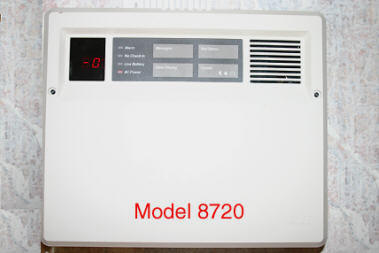
Shared Knowledge
"AT&T Home Security System - Fixing a "No-Check-in "Universal Transmitter"
8 January 2010
Updated 29 Dec 2011

Summary: to fix a persistent "No Check-in", increase the signal strength of the offending detector/device received by the central controller (easier said than done.)
Background:
One of the functions of the AT&T home security system's central controller (CC) is to receive wireless (radio frequency (RF) ) signals from AT&T home security system detectors/devices.
The line cord from the CC's power adapter serves as the CC's antenna.
The AT&T home security system uses the 40megaherz band for transmissions.
AT&T home security system detectors/devices transmit a signal whenever, there is a security/fire event or a device is tampered with.
AT&T home security system detectors/devices transmit a "check-in" signal once every 12 hours or so.
When the CC is first energized or after a complete system reset, as AT&T detectors/devices send a "check-in" signal, the CC builds a small database of system detector/device identification numbers (ID).
Once a check-in signal is received from an AT&T home security system detector/device, the CC starts a timer and if another check-in for that specific device/detector ID is not received in a 12 hour period, the CC reports a "No Check-in" for the specific device/detector.
The transmitted radio signal from each AT&T home security system detector/device is of very limited power and a function of battery voltage. As battery voltage drops over time, the signal transmitted gets less and less strong.
In an AT&T home security system that was installed correctly, device/detector batteries should last about a year before "No Check-in" begin to occur due to low battery voltage and thus low transmitter signal strength.
Correcting persistent "No Check-ins":
There are several things you can try to correct persistent "No Check-in" problems:
- Obviously replace the 9volt battery with a fresh one. "Persistent" for me means, I put in a fresh battery and everything is ok for a week, a month or perhaps even several months before I get a "No Check-in".
- Remove or reduce objects that are in the "line of sight" from the offending detector/device and the CC. Metal of any kind around a detector or device soaks up transmitter signal.
- Relocate any laptop or other power adapters away from the offending detector/device. Laptop adapters, especially the cheaper Chinese made versions, emit very broad-band RF interference.
- Remove any laptop or other power adapters from around the CC.
- Increase the length of the line cord from the CC's power adapter to the CC. This means opening the CC but is not a complex job. The "antenna" or line cord between the CC's power adapter and the CC can be up to 75 feet in length. Try to get both a vertical and a horizontal run of line cord.
- Do not plug the CC's power adapter into an outlet or even a circuit breaker circuit being shared by a motor. Motors put all sorts of interference on a 120volt circuit and can interfere with the CC receiving a weak device/detector signal.
- Relocate the CC. The best position for a CC is in the middle of all detector/devices and slightly above all detectors or devices. Moving a CC is not overly complicated but you must be able to route the line cord antenna as well as have a phone jack nearby if you want to continue to have remote station monitoring.
- Move the offending device/detector's location. In my home, all first floor windows are protected by a magnetic reed switch attached to an AT&T universal transmitter fixed to the window frame at the bottom of the window. As my CC's antenna is in the attic, moving the offending universal transmitter up several feet might increase the signal the CC receive's enough to eliminate persistent "No Check-in"
- Add an external antenna to the offending detector/device. I found this did not help my situation.
.jpg)
.jpg)
- If device/detector transmitted RF signal strength is a function of device/detector battery voltage, replace battery with a 9 volt power adapter such that the device/detector's voltage never decreases with time. Of course you will loose protection for the adapter device if power should go out but 99% of the time, you will be covered.